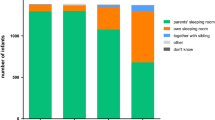Abstract
Sudden infant death syndrome (SIDS) is a target for public health care in Germany. The aim of this study was to monitor data on risk-related behavior in the population of Hamburg, Germany, in order to respond to changes quickly and to estimate the effectiveness of prevention activities. Data have been gathered using the sentinel system with repeated surveys (1996, 1998, 2001, and 2006) in pediatric practices, thus allowing an estimate of the prevalence of risk factors in an urban population, both transversally and vertically. From 1996 to 2007, the SIDS rate in Hamburg fell from 0.9/1,000 live births to 0.1. The prevalence of infants sleeping prone declined from 8.1% in 1996 to 3.5% in 2006. In this small subgroup, up to 81.7% (2006) of the caretakers were well aware of the risk of sleeping prone. The prevalence of infants sleeping on their sides fell from 55.3% in 1998 to 10.6% in 2006. The sentinel setting is suitable for gathering risk-related data on SIDS. Despite the fact that, so far, no nationwide back-to-sleep campaign has been instituted in Germany, local campaigns have proved successful in reducing prone sleeping for infants. Moreover, the substantial reduction of side sleeping within a short time span going along with a reduced SIDS rate is an indicator of the effectiveness of prevention activities on a local basis.



Similar content being viewed by others
References
Stanley FJ, Byard RW (1991) The association between the prone sleeping position and sudden infant death syndrome (SIDS): an editorial overview. J Paediatr Child Health 27:325–328
Engelberts AC, de-Jonge GA (1990) Choice of sleeping position for infants: possible association with cot death. Arch Dis Child 65:462–467
Mitchell EA, Aley P, Eastwood J (1992) The national cot death prevention program in New Zealand. Aust J Public Health 16:158–161
Schellscheidt J, Ott A, Jorch G (1997) Epidemiological features of sudden infant death after a German intervention campaign in 1992. Eur J Pediatr 156:655–660
Wennergren G, Alm B, Oyen N et al (1997) The decline in the incidence of SIDS in Scandinavia and its relation to risk-intervention campaigns. Nordic Epidemiological SIDS Study. Acta Paediatr 86:963–968
Wigfield R, Gilbert R, Fleming PJ (1994) SIDS: risk reduction measures. Early Hum Dev 38:161–164
Willinger M, Hoffman HJ, Hartford RB (1994) Infant sleep position and risk for sudden infant death syndrome: report of meeting held January 13 and 14, 1994, National Institutes of Health, Bethesda, MD. Pediatrics 93:814–819
Kleemann WJ, Schlaud M, Fieguth A, Hiller AS, Rothamel T, Tröger HD (1999) Body and head position, covering of the head by bedding and risk of sudden infant death (SID). Int J Legal Med 112:22–26
Bajanowski T, Brinkmann B, Vennemann M (2006) The San Diego definition of SIDS: practical application and comparison with the GeSID classification. Int J Legal Med 120:331–336
Vennemann M, Rentsch C, Bajanowski T (2006) Are autopsies of help to the parents of SIDS victims? Int J Legal Med 120:352–354
Wedekind H, Schulze-Bahr E, Debus V et al (2007) Cardiac arrhythmias and sudden death in infancy: implication for the medicolegal investigation. Int J Legal Med 121(4):245–257
Bajanowski T, Brinkmann B, Mitchell EA (2008) Nicotine and cotinine in infants dying from sudden infant death syndrome. Int J Legal Med 122:23–28
Scragg RK, Mitchell EA (1998) Side sleeping position and bed sharing in the sudden infant death syndrome. Ann Med 30:345–349
Poets CF, Jorch G (2000) Deutsche Akademie für Kinderheilkunde und Jugendmedizin: Stellungnahme zum Thema “vermeidbare Risikofaktoren für den plötzlichen Säuglingstod”. Monatsschr Kinderheilkd 11:1064–1068
Rutstein DD, Mullan RJ, Frazier TM, Halperin WE, Melius JM, Sestito JP (1983) Sentinel health events (occupational): a basis for physician recognition and public health surveillance. Am J Public Health 73:1054–1062
Van Casteren V (1987) A descriptive study on sentinel health information systems with GP’s in the countries of the European Community. Institut d’hygiène et d’épidémologie, Brüssel
Deffner G, Grieve P Klöckner A, Kurme A (1989) Kinderärztliche Beobachtungspraxen. Der Kinderarzt 20:420–425
Ahlbom A, Norell S (1990) Introduction to modern epidemiology. Epidemiology Resources, Chestnut Hill, MA
Fleming PJ, Blair PS (2005) How reliable are SIDS rates? The importance of a standardised, multiprofessional approach to “diagnosis”. Arch Dis Child 90:993–994
Findeisen M, Vennemann M, Brinkmann B et al (2004) German study on sudden infant death (GeSID): design, epidemiological and pathological profile. Int J Legal Med 118:163–169
L’Hoir MP, Engelberts AC, van-Well GT et al (1998) Risk and preventive factors for cot death in The Netherlands, a low-incidence country. Eur J Pediatr 157:681–688
Vennemann MM, Findeisen M, Butterfass-Bahloul T et al (2005) Modifiable risk factors for SIDS in Germany: results of GeSID. Acta Paediatr 94:655–660
Jorch G, Findeisen M, Brinkmann B, Trowitzsch E, Weihrauch B (1991) Bauchlage und plötzlicher Säuglingstod. Dtsch Arztebl 88:C–2343–C-2346
Fleming PJ, Blair PS, Bacon C et al (1996) Environment of infants during sleep and risk of the sudden infant death syndrome: results of 1993–5 case-control study for confidential inquiry into stillbirths and deaths in infancy. Confidential Enquiry into Stillbirths and Deaths Regional Coordinators and Researchers. BMJ 313:191–195
Mitchell EA, Tuohy PG, Brunt JM et al (1997) Risk factors for sudden infant death syndrome following the prevention campaign in New Zealand: a prospective study. Pediatrics 100:835–840
Bajanowski T, Vennemann M, Bohnert M et al (2005) Unnatural causes of sudden unexpected deaths initially thought to be sudden infant death syndrome. Int J Legal Med 119:213–216
Acknowledgments
The authors like to thank the Hamburg Alliance against SIDS for 14 years of excellent cooperation.
Author information
Authors and Affiliations
Corresponding author
Rights and permissions
About this article
Cite this article
Sperhake, J.P., Zimmermann, I. & Püschel, K. Current recommendations on infants’ sleeping position are being followed—initial results of a population-based sentinel study on risk factors for SIDS, 1996–2006, in Hamburg, Germany. Int J Legal Med 123, 41–45 (2009). https://doi.org/10.1007/s00414-008-0298-3
Received:
Accepted:
Published:
Issue Date:
DOI: https://doi.org/10.1007/s00414-008-0298-3




